Yesterday morning, when the other hens got busy with their days, Jasper stayed on the roost. Something was wrong.
I went outside to check on her. She was in a nesting box between the two broodies.
I set her down in the barn to see what I could see. It was obvious that she was in distress because her vent was distended and pulsing.
I was there at the right time. Jasper pushed out some clear fluid – egg white? Then this got stuck:
I gently helped her by pulling it out. A soft shell. Chickens will eat this, so I was fortunate to see it. It gives me a good clue as to what is wrong with Jasper.
Soft shelled eggs are not easy to lay. Sometimes they break inside of the hen, and even if they don’t, the hen isn’t designed to expel the equivalent of a rough deflated balloon. Sometime the hen can’t push it out, the shell stays inside of her, forms a mass and blocks the tract. In the worst case scenario it becomes infected, the reproductive tract breaks, solidifies around the shell, and then gets pushed out in the form of lash. Meanwhile, yolks continue to form, dropping into the body cavity, and becoming infected. The hen eventually dies.
Jasper is in her fourth year of lay. Egg-making glitches are not a surprise. There’s only so much that I can do. The hens have a good diet, with plenty of calcium for shell production. However, as a hen ages, she sometimes loses the ability to process essential minerals. That might be Jasper’s situation. Of concern to me is that she expelled a white and a shell, but no yolk. Where did that go? Perhaps she’s no longer making yolks, and this egg was the last that she’ll produce and there won’t be any more problems. Or, perhaps that yolk is no longer getting into the reproductive tract, but is dropping into her body cavity. In that case, she’s an internal layer, which will eventually kill her. I just don’t know.
What I do know is that I can give Jasper some relief right now with my Spa Treatment. I want to make sure that her reproductive and digestive tracts are cleared out of any blockages. I fed her some bread soaked in a tablespoon of olive oil. Note that Jasper is alert and hungry. That’s a good sign.
I soaked her in a warm epsom salt bath for 10 minutes. She didn’t like that as much as the bread, but she stayed put.
Then I put her back with her flock. Once she pushed out that soft shell, she was once again her active self. Being separated from her flock would have stressed her. Besides, fresh air and exercise helps to move things along.
Twenty-four hours later, Jasper looked absolutely fine.
Time will tell if this was a one-off problem or a fatal glitch. In the meanwhile, I’m hoping that she’ll stop laying and go into an early molt. Not only does she need a break from laying, but this hen goes up to others and asks them to peck at her feathers! It’s time for her to get a new coat.
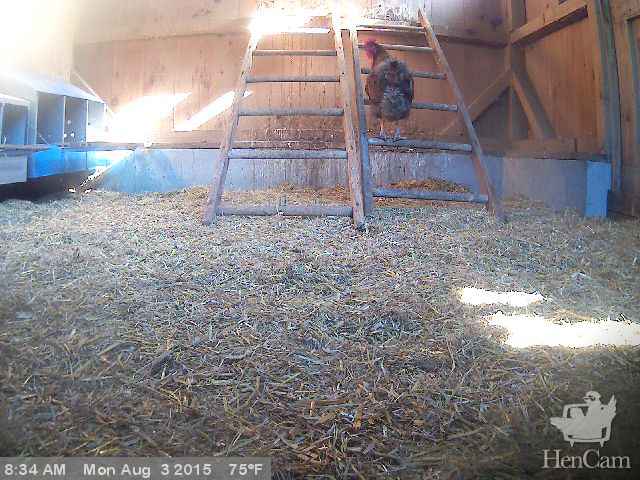
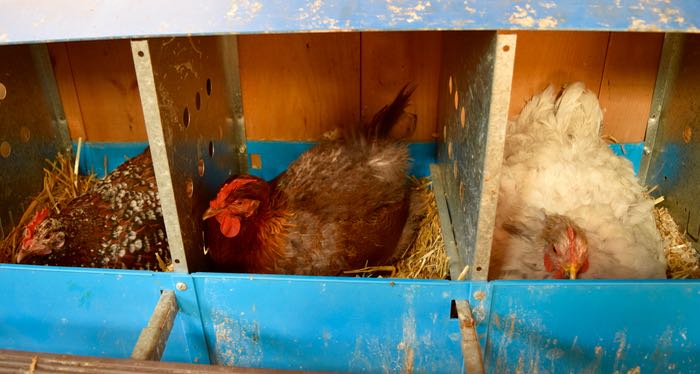
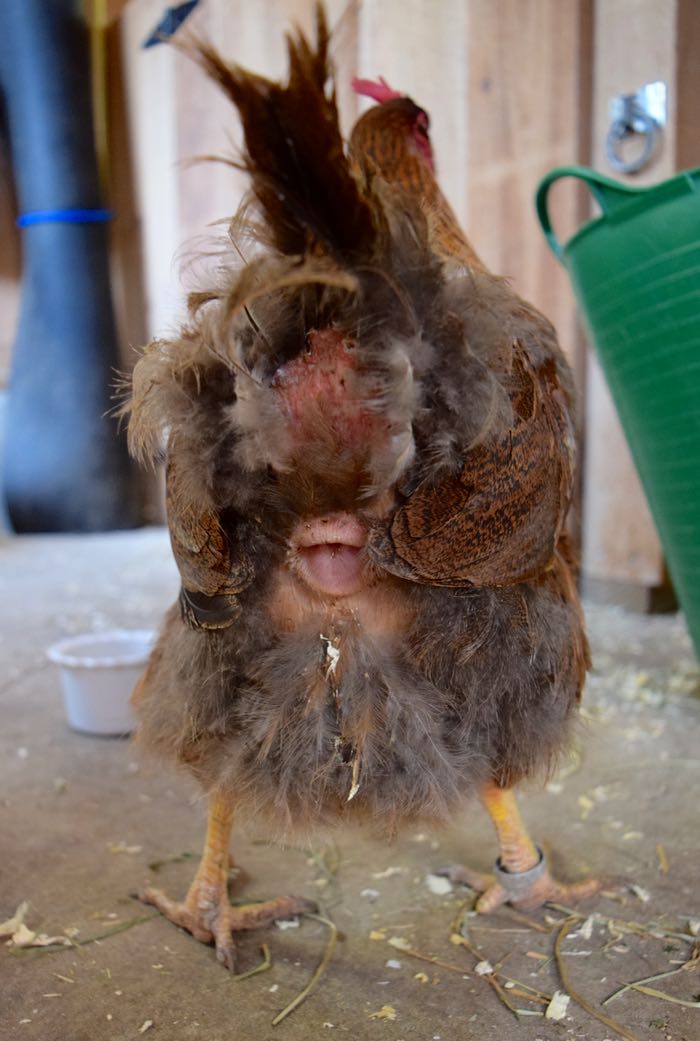
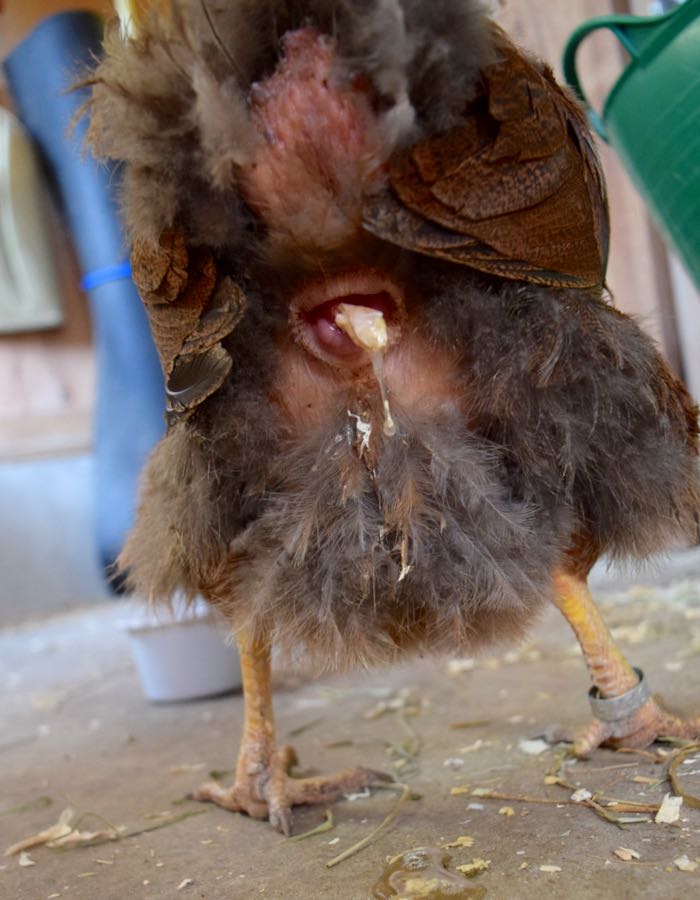

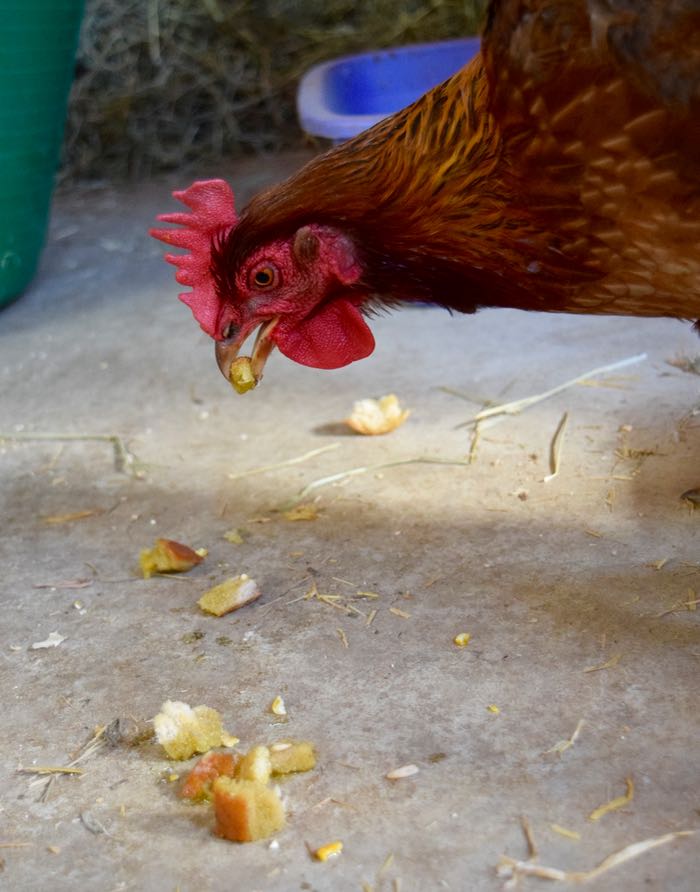
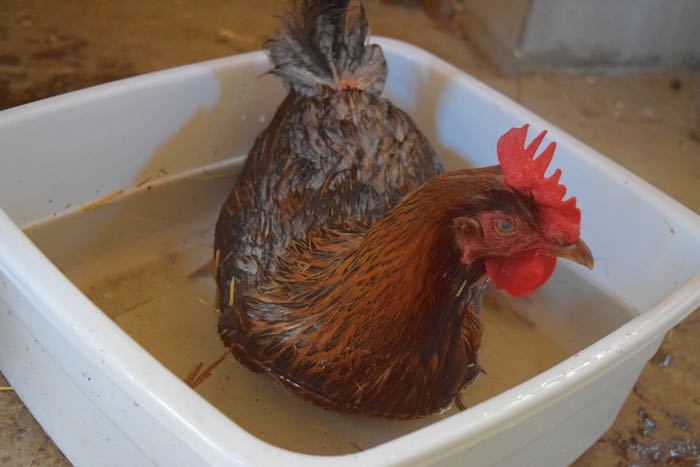


Poor Jasper! I’m glad she’s feeling better and will send best wishes for a one-off issue. On a side note, yuk, my sympathies to you. You must be having some really warm weather to keep being in the 80’s this early in the day!
Humid and miserable, but dropped 20 degrees when the t-storms came through.
Wouldn’t hurt to give her a hit of calcium too. That gives her the boost she needs to put a proper shell on the next one. I keep both liquid and powdered calcium on hand. Mix it w/ a treat and give it to her.
Wouldn’t hurt, but I doubt that it will help. Getting calcium to the egg is complicated. First it gets consumed, then digested. Then it goes into the bloodstream and gets laid down into bone. Then it gets taken out of the bone, back into the blood, over to the shell gland, and laid down as egg.
You’d be surprised. The liquid works better than the powder. Do it later in the evening as most shells are formed during the night. I have a hen who has trouble w/ soft shelled eggs. Has for YEARS so I’ve done lots of experimenting. She gets a half teaspoon in a treat every evening and lays a perfect shelled egg. If I forget and skip a dose, I get a soft shelled egg.
Not much harm in trying.
Interesting! How old is she now?
She’s just shy of 5 years old. Still lays 4-5 days a week.
I noticed her on the roost yesterday and not moving. I was worried about her. Glad she is feeling better.
This is off subject…though glad Jasper is much better.
I have not been able to view hen cam or the new cam for some time. I get an error. Is there anything I can do at my end?
As always many thanks for your great site.
I have been having the same problem as Marilyn. I was able to watch the new cam for a day, and the next morning I couldn’t watch either can on my laptop. I can watch on my iPhone. I have spent so many hours trying to fix it, but with no luck.
I love watching and reading everyday!! Thank you and Steve.
GMS
Good news that Jasper is healthy! I’d be upset if you had to lose 2 hens within a week.
Glad Jasper is doing better. Great information to study and something to look out for.
I was reading some of the comments above about giving even more calcium and have looked at your FAQ’s about feed. I do plan on giving my girls free choice oyster shells when they start to lay (they are only a little over 3 weeks now), but I also have a little Roo. I have been trying to study up on the feed and some say the roo will eat layer pellets, but too much calcium isn’t good for him, but an all flock crumble has lower calcium and higher protein. So what to do?
He can eat the layer pellets and he’ll avoid the free-choice calcium. He should be fine.
Thanks Terry.
Really glad Jasper is back to her old self, hopefully just a glitch…:)
Marilyn and Gayle if you go back 6 blogs to one called IT Guy, Steve has given some tips to try, hope this helps. I had to get mine sorted by a friend cost me a pie and some brownies , but well worth the effort.
That must have been very uncomfortable for Jasper. Lucky for her that you were there to be able to help her out.
I just checked in with the new cam and noticed that Jasper is sitting under the ramp, not doing much. It’s raining a bit where you are by the looks of it, so the spot under the ramp is probably a reasonably dry place for an afternoon nap. I hope that’s what she’s doing.
Tornado watch! She’s seeking shelter. All clear now, but thunder, lightning and rain.
Thanks Nan. I will go back and read that. GMS
Glad to see that Jasper is looking healthy after her spa treatment. A little pampering is good for any girl!
Love the glare from the spa-tub. Not what she had planned for the day, I guess.
Hi Terry,
Did the bread with olive oil help to move things along? I had a similar issue with my hen today. She didn’t get off the roost to free range and instead went into the run and laid two eggs in a row in front of me that weren’t easy for her to pass.The second egg had a rubber shell. She was fine afterwards, but because I have a mixed flock, I’m feeding them all the same feed, except I have oyster shells for the hens as well. She isn’t getting enough calcium. What feed do you suggest for a mixed flock of hens and 12 week olds?
The olive oil helps to move things in the intestinal tract along – sometimes the repro tract pushes on the intestines. and so this helps. Two eggs is a sign of something bad – a hen should make only one egg in a 25 hour cycle. If two are there, it means that one was blocking the other. I wouldn’t let the 12 week olds have access to calcium Give it another month.
Hi Terry, I’ve a question about chicken age and chicken illnesses: would you say most birds that have problems are after their second or third year of age, or have you kept stats on each bird’s age/illness trends? I’ve had a few minor losses here and there at different ages with different factors, but overall I’ve been well-off in terms of disease or illnesses. Jp
I’ve kept records on all of my birds, but haven’t turned them into stats. I can say that respiratory diseases happen within the first two years. Cancer, etc. after two. The laying glitches start around year four.
Hi all,
Mr IT Guy here. If you are still having problems viewing the streaming cams, try these steps:
1. Reload the web page. If this doesn’t resolve your issue, move on to step 2.
2. Clear your browser’s cache, then reload the web page. Didn’t work? Proceed to step 3.
3. Clear your browser’s cache and cookies, restart your browser (or reboot your device), then navigate back to the page you were on.
4. Install the latest version of Adobe Flash Player. You can download the latest version here.
That last step is critical! The new streaming setup only works with Flash versions 11.2 and higher.
Sorry for all the troubles you are having, and I appreciate your support. Hopefully we’ll get all this settled soon.
Thanks,
Steve (Mr IT Guy)
What is internal egg laying I have a hen who is retaining liquid inside of her bottom somehow. It’s happened before, the liquid ends up so full that she ends up dying. The last one that died I open her up after she passed away and the liquid inside was clear. Thoughts?
The reproductive tract is not a closed system. The yolk get released from the ovary and have to be “caught” by the infundibulum. Sometimes they drop into the body cavity. Sometimes the eggs begin to be formed but instead of going forward, they back out and into the cavity. There are other ailments that cause fluid in the body cavity, including ascites – that causes a clear fluid. (Use my blog search button to look for more info on these issues.)
This is a very good, informative post (as usual). I think that soft shelled or no shell eggs seems to be quite a common problem. I tend to agree that this is age related, but my two and half year old hybrid hen has started laying soft shelled eggs. I can always tell when one is due as she goes “off” in the afternoons (very quiet and still). As soon as she has expelled the soft or shellless egg, she is fine and goes back to normal. I do give her oyster shell and egg shells (they do not seem to eat them though) and I also gve “Nutrobal” – powder calcium supplement and occasionally cod liver oil to aid absorbsion of the calcium. I would be interested to know what liquid calcium people use (maybe this is better than the powder). When you consider the complex internal workings of a hen, it is not really suprising these glitches occur. Always good to know how everyone else deals with these problems.
The hybrid hens experience this first because they’ve been laying more than the others. My Polish, who rarely laid an egg, had (when she did lay them) hard-shelled eggs to the very end.
I agree, a very good, informative post (as usual). Would you consider giving a chicken (internal) anatomy and function class? I refer to your FAQ all the time and find it so helpful. Thanks.
I have done an advanced health care workshop, with this info in it. Anyone else want me to schedule one?
This is a question for Amy Sanchez, what type of liquid calcium do you use?
One of my hens (about 12 years ago) never used to lay at all when I first got her – or so I thought; then one day I just happened to be there when she laid a soft shelled egg and all the other birds rushed to fight over who would eat it. This was no nosey / interested / experimental thing – they knew, this had clearly been happening for a while. An old (in his 90s) poultry man I knew (he’s no longer with us) told me to try not letting her eat spinach family greens. Once I started putting the chard, spinach, beetroot tops in the compost and limited the chicken run to other greens she started laying hard shelled eggs. He couldn’t explain why it happened, he said it was only a small percentage of birds it affects but if you own one of those birds it’s always a problem and occasionally it turns up as a new problem in older birds. I’ve never heard this from anyone else before or since. I always avoid that family of greens in the girls diets now and never had a soft shelled egg since.
Vee, this is very interesting. I have fed garden cleanings composed in a large part of all of these. Another blogger has said if you feed spinach, do it sparingly, and make sure there’s apple cider vinegar in the water to counteract the calcium binding. But I never carried it through to the rest of the spinach family…
I do have softer shells on the eggs sometimes, even though there’s plenty of calcium. We have bell waterers and the raw apple cider vinegar, in warm weather, causes a bloom that plugs the filter and hoses.
So now I need to rethink garden cleanings….
Spinach has oxalic acid in it, which can bind with calcium and prevent its uptake. As with everything, it’s a tad more complicated than that… not all hens like spinach, so some in your flock will consume too high a level and others won’t, and some hens have a predisposition to soft eggs.
Of course it will be good while before my even think about laying, but I have already been letting them out in their run (our weather has been like yours). They love getting a bit of squash, cabbage, green beans, weeds and Japanese Beetles, etc. I grow winter greens of kale, spinach, collards, mustard, etc.,but should those be limited since they all have calcium or does the acv help absorption. Or is it better to avoid the spinach family which I suppose would include lamb’s quarters. I already put up some squash and veggies (in the freezer) to be taken out this winter for them and of course if things go well, it looks like I will have more pumpkins that I know what to do with.
Just limit the spinach. I’ve read some studies that a constant intake of ACV isn’t effective. No harm but not as therapeutic as is thought. Occasional use for a specific situation is more beneficial. However, you can use it all summer to keep the drinking water free of algae.
We did try ACV for the drinking water, but as I said, it blocks bell waterer tubes and filters with an overgrowth.
Were you using the really good ACV with the mother in it? Cheap Heinz from the supermarket doesn’t do that – but it likely doesn’t have the curative benefits, either :) I use simple waterers, no tubes, so I don’t have that problem, either.